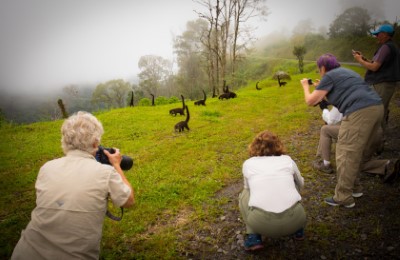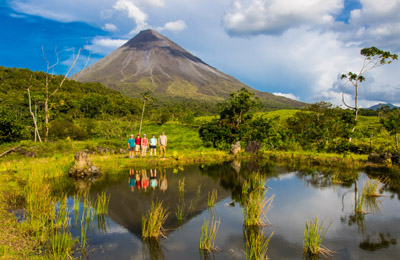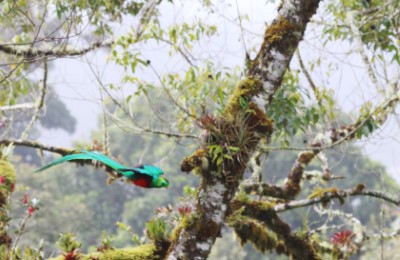Costa Rica’s Ecolodges
It seems to have it all – active volcanoes, lush cloud forests, lowland jungles, rolling savannas, black volcanic and coral sand beaches, and some of the finest forest-lined rivers on the planet. Such spectacular settings amplify the interaction with the country’s exotic flora and fauna. The Nation has had the foresight to protect nearly 25% of its land in a remarkable series of park systems and reserves while maintaining community development and measured economic growth. The result has made them pioneers and global leaders in eco-tourism. Couple this with a well-educated and peaceful host
population, and you have the makings for an ideal nature-rich trip.
 Travelers enjoy photographing a troop of coati ©Alex Arias
Travelers enjoy photographing a troop of coati ©Alex Arias
My first visit to Costa Rica was a 14-day natural history expedition that took me from coast to coast through a variety of national parks and private reserves led by a local biologist guide. The exhilaration of that first journey led to more adventures in Costa
Rica, none so exciting as my journey to work with World Wildlife Fund (WWF) and several local NGO’s in three communities: Arenal, Santa Elena/Monteverde and Bijagua. The aim of this community-based development project was to assist in efforts to shift from deforestation and intense agriculture towards more environmentally-sound economic activities that included eco-lodges, organic farming, medical plant nurseries, and cottage industry development – all towards an environmentally sustainable future.
Catarata Eco-Lodge offers a variety of cozy rooms. I have been back more than once to visit Catarata Eco-Lodge, one of three eco-lodges originally assisted by the WWF collaborative project. What is unique in the world of eco- lodges is that this is community-owned and operated. Moneys generated from visitors support projects that include orchid rehabilitation, paca breeding, organic farming and butterfly nurseries. Three generations of locals can often be observed in the lodge
activities and projects. Catarata Eco-Lodge gardens overlook the active Arenal Volcano. Arenal volcano@Alex Arias.
 A big draw for visitors here is the famous Arenal Volcano, visible from the lodge on a clear day. An evening visit to the local hot springs is also a delight, always keeping an eye open for glimpses of the giant flow of incandescent red lava running down the mountain slopes. The lodge also serves as a base for exploring the nearby forests, visiting the waterfalls (cataratas) and rafting on the Sarapiquí River.
A big draw for visitors here is the famous Arenal Volcano, visible from the lodge on a clear day. An evening visit to the local hot springs is also a delight, always keeping an eye open for glimpses of the giant flow of incandescent red lava running down the mountain slopes. The lodge also serves as a base for exploring the nearby forests, visiting the waterfalls (cataratas) and rafting on the Sarapiquí River.
Sarapiquí
River nature-spotting excursion. The Sarapiquí region itself is another wonderful region to include in an ecological journey to Costa Rica. It is located about two hours each from Arenal or from the capital San Jose. I highly recommend a stop enroute at La Paz Waterfalls & Gardens. This private wildlife sanctuary has lush tropical rain forest, flowing white rivers, spectacular waterfalls, birds, butterflies, monkeys, hummingbirds, snakes, felines and frogs.
Another eco-lodge that deserves recommendation is La Quinta. What was once a ten- acre livestock farm has been regenerated and reforested with native trees and gardens to complement some old-growth forest on the riverside. The forests and wild gardens attract abundant bird diversity, butterflies, frogs, and some small mammals too. La Quinta Sarapiquí Lodge has ten acres composed of reforested native trees, an old-growth forest on the riverside and tropical gardens. The small lodge is family owned and operated and locally staffed. The Inn is certified atthe highest qualification level (5 leaves) by the Costa Rican Tourism Board with its Certification for Sustainable Tourism (CST). Even though this place is larger than some other eco-lodges, its popularity with ecotourists means that early bookings are essential.
Perhaps the quintessential eco-destination in Costa Rica is Monteverde on the continental divide where weather patterns from both the Caribbean Sea and Pacific Ocean create a wonderful example of a cloud forest ecosystem. Plan to stay a minimum of three nights to allow ample time to search for birds, monkeys and other wildlife in the cloud forest and dry forests that are protected in national and private reserves. Look here for one of the most famous inhabitants, the Resplendent
Quetzal. The Monteverde forest is home for many other interesting bird species such as the Emerald Toucanet, Black Guan, Purple Throated Mountain Gem (hummingbird), and the Blue Crowned Motmot, just to mention a few found here.
 Resplendent Quetzal bird ©Marco Fallas
Resplendent Quetzal bird ©Marco Fallas
One of my favorite eco-lodges in this neck of the woods is Hotel Fonda Vela at a 4,200-foot/1,400-meter elevation in the Monteverde Cloud Forest. After a long closure, this
informal hillside property opened again in 2017. The gardens and trails of its 35 acres are always spectacular with sightings of some sixty different species of migratory birds,
and over 200 species of non-migratory birds. The owners, brothers Paul and Steven Smith, grew up on this property and went on to build and manage the hotel. “Our goal,”
they say, “is to promote a greater visitor understanding of the environment and this unique habitat.”
And finally, in the Northwest of Costa Rica is the tiny community of Bijagua nature travelers can find three small eco-lodges (Las Heliconias, Celeste Mountain Lodge, and Rio Celeste Hideway) listed in order from basic to boutique luxury.
These accommodations sit on the edge of the pristine Tenorio Volcano National Park, one of the country’s youngest parks created in 1995. There a series of hanging bridges allows incredible canopy views of the flora and birds. Walking one time one of the lodge owners, we hiked to the pristine Rio Celeste. The azure waters of celestial blue were so magical that I knew at that moment I would name my soon-to-be-born daughter, Celeste, after this beautiful place. Someday soon I hope to return there with her.

